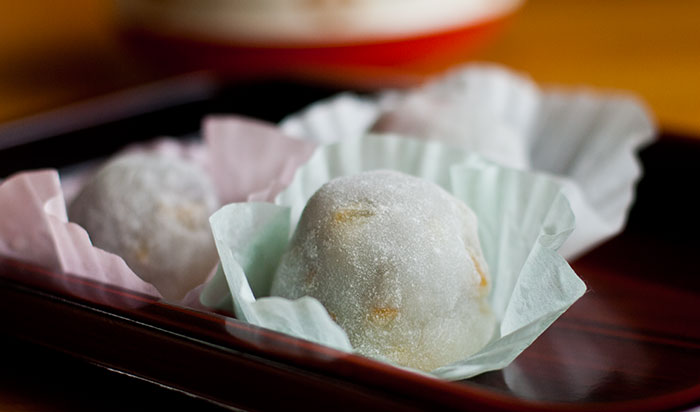
Yuzu Daifuku
| Ingredient | 10 Daifuku | 10 Daifuku |
|---|---|---|
| Outer Wrap | ||
| shiratamako (sweet rice flour) | 2⅔ oz. | 75g |
| water | ½ cup | 120ml |
| sugar | 2⅔ oz. | 75g |
| potato or corn starch | as needed | as needed |
| candied yuzu peel | ¼ cup | ¼ cup |
| Filling | ||
| koshian | 10 oz. | 300g |
A variation on traditional daifuku, the addition of candied yuzu rind to the gyūhi wrap adds a bright, citrusy tang that’s hard to resist. The only challenge is actually finding yourself candied yuzu rind—the fragrant, orange-like fruit is nearly unknown in the English-speaking world.
Preparation
- Prepare a batch of azuki bean paste for the filling; freeze any you don’t end up using.
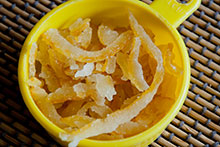 Chop the candied yuzu rind into small pieces.
Chop the candied yuzu rind into small pieces.- Prepare the surface you will use to work with the dough (a cookie sheet or cutting board, for example) by dusting generously with potato or corn starch to prevent it from sticking.
Directions
- Make balls of anko.
Divide the anko into ten balls, each about 2.5 cm (1 inch) in diameter. To divide the anko easily, you can roll it into a cylinder, then cut it into ten pieces and roll them into balls. If it’s too sticky to work with, lay the balls out on a baking sheet for a while until they dry out a little.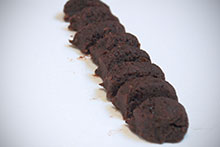
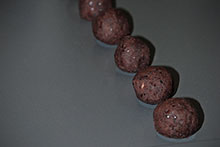
- Mix gyūhi ingredients and heat.
Put the rice flour in a microwavable bowl and add water a little at a time, whisking constantly so it doesn’t clump. Once the water and flour are completely mixed, add sugar and whisk until smooth. Cover and microwave for one minute on high. 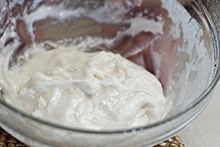 Mix and heat again.
Mix and heat again.
At this point it is halfway done; some liquid will have separated on top. Wet a wooden spatula or spoon and mix again very thoroughly. Cover and microwave for another minute.- Add yuzu.
Add the candied yuzu rind bits and stir until well mixed.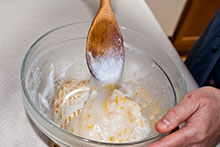
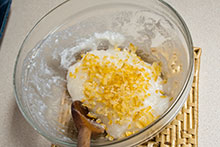
- Make gyūhi disks to wrap the anko.
Drop the gyūhi dough onto the surface you floured with potato or corn starch. Cut the dough into ten equal chunks. Coat your hands with starch so it doesn’t stick, then flatten the dough with your fingers into small disks. The center of the disks should be thicker than the edges, since it will stretch.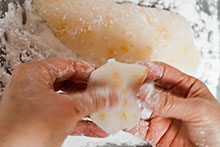
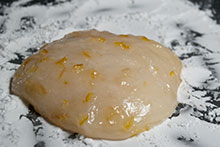
- Wrap anko balls.
Lay each gyūhi disk in your palm, put an anko ball in the middle, and stretch the gyūhi around it, pinching the bottom to seal. The finished daifuku should be about the size of a ping-pong ball.
Notes
- The finished daifuku are supposed to end up with a layer of starch on the outside; this keeps them from sticking to fingers and plates.
- The smoother texture of koshian goes well with the smooth outer layer of daifuku, but if you prefer you could also use tsubuan.
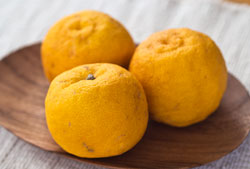 Yuzu is an Asian citrus that isn’t generally eaten straight; instead, the juice or very fragrant peel is used in cooking, as in this recipe. The yellow fruit is about the size and shape of an orange, and the unique flavor could be compared to a cross between orange and grapefruit. Although extremely cold-tolerant, they have yet to catch on in the United States or elsewhere, so the plant and fruit are both quite difficult to find; try a Japanese specialty market for candied yuzu rind.
Yuzu is an Asian citrus that isn’t generally eaten straight; instead, the juice or very fragrant peel is used in cooking, as in this recipe. The yellow fruit is about the size and shape of an orange, and the unique flavor could be compared to a cross between orange and grapefruit. Although extremely cold-tolerant, they have yet to catch on in the United States or elsewhere, so the plant and fruit are both quite difficult to find; try a Japanese specialty market for candied yuzu rind.- If you’re interested in trying your hand at growing your own yuzu, they’re known as the most cold-tolerant of any citrus, happily growing even in central mountain regions of Japan that regularly see temperatures below freezing and some snow in winter. Though uncommon, they are available from some nurseries in the United States, including a dwarf version from Four Winds Growers in California, where we got ours. The picture here shows some unripe fruit on our tree.

